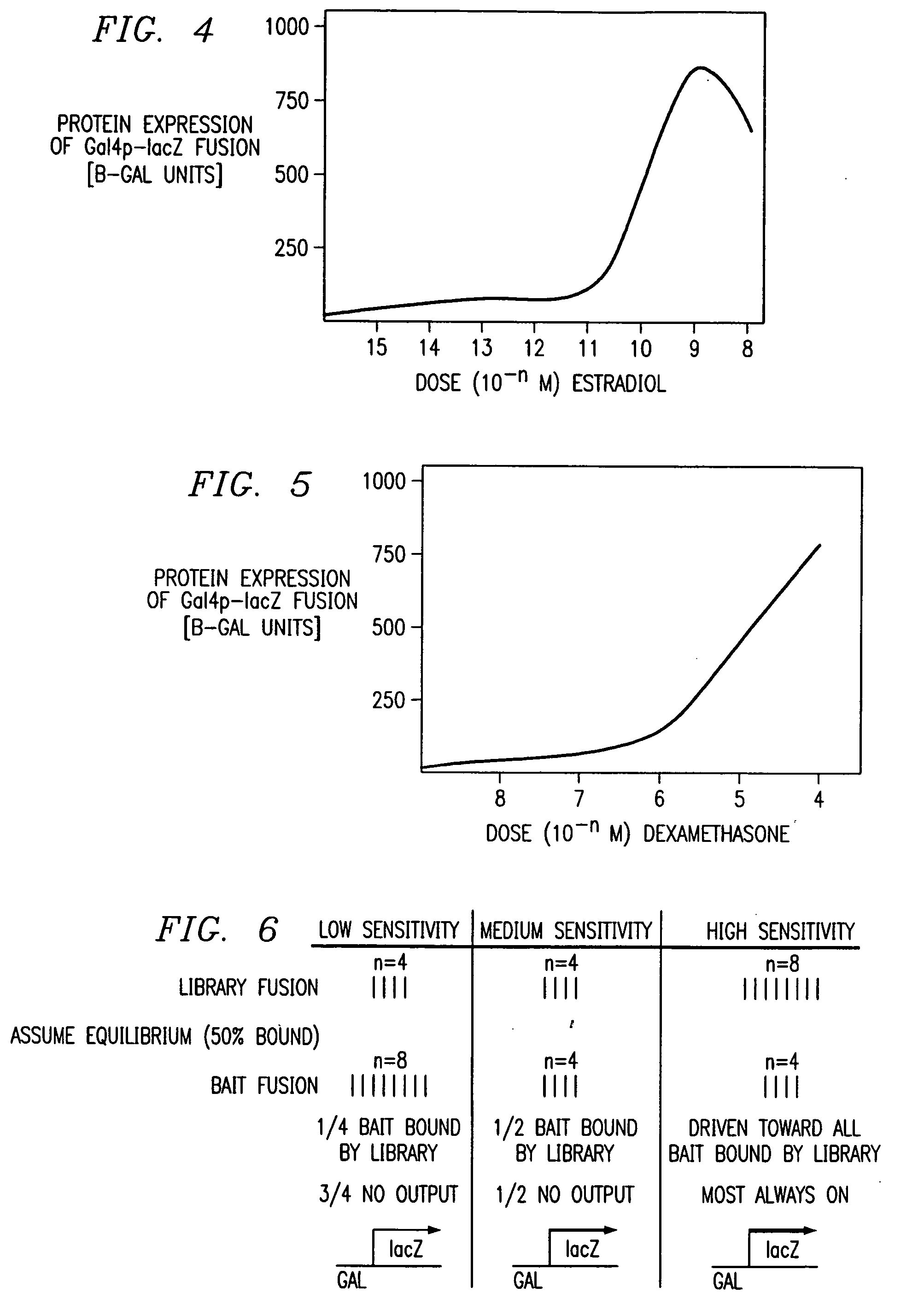Adjustable sensitivity, genetic molecular interaction systems, including protein-protein interaction systems for detection and analysis
a technology of molecular interactions and sensitivity adjustment, applied in the field of adjustment of sensitivity, genetic molecular interaction systems, including proteinprotein interaction systems for detection and analysis, can solve the problems of incomplete inability or prolonged time required to elucidate important biologically relevant interactions, failure to detect relevant biological interactions, and current methods of selection are limited to "all or nothing"
- Summary
- Abstract
- Description
- Claims
- Application Information
AI Technical Summary
Benefits of technology
Problems solved by technology
Method used
Image
Examples
example 1
Interaction Hybrid System Adjusted to Give Variable Quantitative Reporter Output without Modifying the Reporter System
[0054] As noted above, the Brent lab has shown that a given set of two-hybrid protein interactors yield a uniform quantitative reporter output directly proportional to their strength of interaction (Estojak et al., 1995). Utilizing the novel adjustable yeast interaction hybrid system (IHS), introduced and described as a more preferred embodiment in the paragraphs above, three sets of proteins pairs previously demonstrated to interact in a two-hybrid system are demonstrated to give variable levels of reporter output when expressed at different relative concentrations. The level of expression of the first hybrid protein containing the bait is proportional to the concentration of estradiol, and the level of the second hybrid protein containing the prey derived from a library is proportional to dexamethasone concentration (Kralli et al., 1995; Gaido et al., 1997 (FIGS. 4...
example 2
Interaction Hybrid System Adjusted to Low Sensitivity for Promiscuous Bait
[0058] When low sensitivity is desired, as in the screening of the mammalian baits IRAK kinase, its Drosophila homolog Pelle kinase, or its plant kinase homologues, high expression of the bait hybrid protein is achieved using 10.sup.-9 M estradiol (for example, as in Table 2, below). Low relative expression of the library / prey hybrid proteins is achieved only at 10.sup.-7 M dexamethasone (for example, as in Table 2, below). The excess of bait hybrid protein decreases the background expression of weak and irrelevant interactions common to these kinases (refer to FIG. 6). This enables the successful selection, screening and discovery of their respective interactions with activators and scaffolds from a random cDNA library. By muting the background signal, many irrelevant interactions are reduced or eliminated which otherwise would interfere with timely and cost-effective analysis of these screening results.
2TABL...
example 3
Interaction Hybrid System Adjusted to High Sensitivity for Poor Quality Bait
[0060] If high sensitivity is desired, as in the screening of the mammalian baits Interleukin-1 receptor, or its Drosophila homolog Toll, or its plant or mammalian homologues, minimal expression of the bait hybrid protein is achieved using 10.sup.-9M estradiol. High relative expression of the library / prey hybrid protein is achieved using 10.sup.-5M dexamethasone. The excess of library / prey hybrid protein apparently drives the weak interaction equilibrium toward forming heterodimers; more of the limiting bait hybrid proteins are occupied at a given time by interaction with the abundant library / prey hybrid proteins (FIG. 6). The system thereby detects the weak (high Kd) interaction of these receptors with their cytoskeletal adapter and cytoplasmic proteins.
3TABLE 3 High sensitivity Screen with toll Receptor intracellular domain as bait Total False Bait Estradiol Dexamethasone Positives Positives Toll 10.sup.-9...
PUM
| Property | Measurement | Unit |
|---|---|---|
| hydrophobic | aaaaa | aaaaa |
| colorimetric analysis | aaaaa | aaaaa |
| strength | aaaaa | aaaaa |
Abstract
Description
Claims
Application Information
 Login to View More
Login to View More - R&D
- Intellectual Property
- Life Sciences
- Materials
- Tech Scout
- Unparalleled Data Quality
- Higher Quality Content
- 60% Fewer Hallucinations
Browse by: Latest US Patents, China's latest patents, Technical Efficacy Thesaurus, Application Domain, Technology Topic, Popular Technical Reports.
© 2025 PatSnap. All rights reserved.Legal|Privacy policy|Modern Slavery Act Transparency Statement|Sitemap|About US| Contact US: help@patsnap.com


